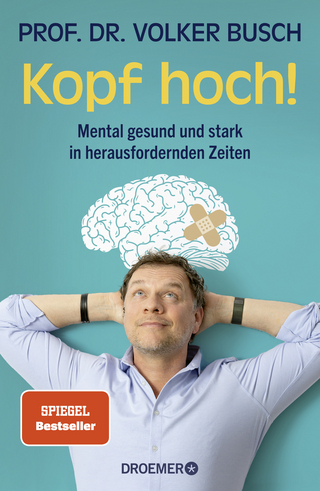
The Man Who Wasn't There
Tales from the Edge of the Self
Seiten
2016
Penguin USA (Verlag)
978-1-101-98432-1 (ISBN)
Penguin USA (Verlag)
978-1-101-98432-1 (ISBN)
An Oliver Sacks-style tour of the neuroscience of schizophrenia, autism, Alzheimer's, epilepsy, Cotard's syndrome and out of body experiences in which people lose some critical sense of themselves - with sometimes bizarre and often painful results - revealing the absolute importance of our sense of self, however fragile and its nurture.Understanding "the self" has long been thought to be neuroscience's greatest challenge, a mystery perhaps that never can be solved.
We are who we are - but mystics, Buddhists and even scientists have told us the self is an illusion. We know who we are but then no matter how successful and healthy you are, sometimes we wonder - who is that inside our heads? Who am I really? Are you sure you know?
With the explosion of progress in the scientific investigation of conditions such as schizophrenia, autism, Alzheimer's, ecstatic epilepsy and Cotard's syndrome, as well as out of body experiences and Asperger's, we are learning about the Self at a level of detail that Descartes ("I think therefore I am") could never have imagined. Is the Self merely your ongoing autobiography, your personal narrative, as Antonio Damasio has suggested? Alzheimer's disease is illuminating the role of memory in the construction of that narrative as Ananthaswamy shows. The same part of your brain that remembers your life story is constructing your future life story. Is the location of the Self in our grey matter at hand? Those afflicted with Cotard's syndrome think they are already dead - in a way, they believe that "I think therefore I am not". But who - or what - is saying that? Neuroscience has identified specific regions of the brain that, when they misfire, can lead to the self can moving back and forth between the body and a doppelgänger or leaving the body entirely and able to witness it's former body. But, then, where in the brain is the self actually located? As Ananthaswamy elegantly reports, neuroscientists themselves ultimately acknowledge that the self is both everywhere and nowhere in the brain's anatomy.
Here is a magical mystery tour of one of the most ancient mysteries now utterly transformed by cutting edge neuroscience told by a master of science journalism.
We are who we are - but mystics, Buddhists and even scientists have told us the self is an illusion. We know who we are but then no matter how successful and healthy you are, sometimes we wonder - who is that inside our heads? Who am I really? Are you sure you know?
With the explosion of progress in the scientific investigation of conditions such as schizophrenia, autism, Alzheimer's, ecstatic epilepsy and Cotard's syndrome, as well as out of body experiences and Asperger's, we are learning about the Self at a level of detail that Descartes ("I think therefore I am") could never have imagined. Is the Self merely your ongoing autobiography, your personal narrative, as Antonio Damasio has suggested? Alzheimer's disease is illuminating the role of memory in the construction of that narrative as Ananthaswamy shows. The same part of your brain that remembers your life story is constructing your future life story. Is the location of the Self in our grey matter at hand? Those afflicted with Cotard's syndrome think they are already dead - in a way, they believe that "I think therefore I am not". But who - or what - is saying that? Neuroscience has identified specific regions of the brain that, when they misfire, can lead to the self can moving back and forth between the body and a doppelgänger or leaving the body entirely and able to witness it's former body. But, then, where in the brain is the self actually located? As Ananthaswamy elegantly reports, neuroscientists themselves ultimately acknowledge that the self is both everywhere and nowhere in the brain's anatomy.
Here is a magical mystery tour of one of the most ancient mysteries now utterly transformed by cutting edge neuroscience told by a master of science journalism.
Anil Ananthaswamy is a consultant for the London-based New Scientist magazine, guest editor in science journalism at UC Santa Cruz renowned science writing programme and teaches the science journalism workshop at the National Centre for Biological Sciences in Bangalore, India. He has worked at New Scientist in various capacities since 2000, including as staff writer and deputy news editor.He has also written for National Geographic, Discover, The Times and The Independent.
| Erscheinungsdatum | 21.07.2016 |
|---|---|
| Sprache | englisch |
| Maße | 140 x 210 mm |
| Themenwelt | Sachbuch/Ratgeber ► Gesundheit / Leben / Psychologie ► Psychologie |
| ISBN-10 | 1-101-98432-5 / 1101984325 |
| ISBN-13 | 978-1-101-98432-1 / 9781101984321 |
| Zustand | Neuware |
| Informationen gemäß Produktsicherheitsverordnung (GPSR) | |
| Haben Sie eine Frage zum Produkt? |
Mehr entdecken
aus dem Bereich
aus dem Bereich
Buch | Softcover (2021)
Kohlhammer (Verlag)
29,00 €
mental gesund und stark in herausfordernden Zeiten
Buch | Hardcover (2024)
Droemer (Verlag)
20,00 €
der Leitfaden für die Praxis der Akzeptanz- und Commitment-Therapie
Buch (2023)
Arbor (Verlag)
42,00 €


